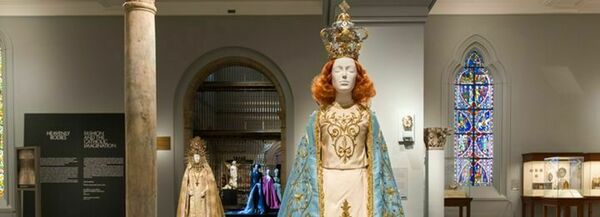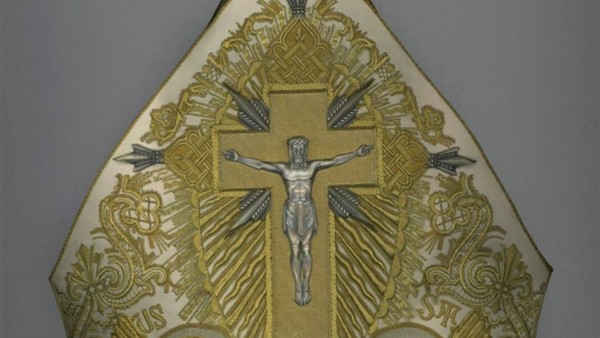The Met’s Costume Institute Exhibition “Heavenly Bodies: Fashion and the Catholic Imagination,” currently on view at the Met Fifth Avenue and The Cloisters until October 8th, threads through galleries of medieval and Byzantine art, bringing the sartorial art pieces into dialogue with the surrounding masterpieces.
The promenade-style exhibit could easily become a gaudy intrusion rather than an exegesis of the beauty already embedded around it. But from the very first runway—a neck-craning collection of evening dresses which march through a hallway of Antiochene mosaics—”Heavenly Bodies” demands a transformation of the viewer’s encounter with the surrounding art. That first dizzying catwalk of gowns both catalyzes new contemplation of the existing art and playfully suggests a core theme of the exhibit—the displayed earthly beauty has, at its heart, a higher telos.
In her May article on the Met Gala, Anne Carpenter posed the question: “Do our things die when we preserve them, or does preserving them keep them alive?” For all the Church is lauded for its tradition and its continual admonishment to our short memories to heed to wisdom of the past, the Church’s task is not, to strictly preserve the past, but rather, the Church seeks to resolve the tension of past and present in the eternal. The Church’s liturgical action overcomes the spatio-temporal divisions in the Communion of Saints, bringing all present in Christ present here and now. Thus, the stones of ancient churches are not ruins when encountered as liturgical spaces, the collector’s-items-vestments are not museum pieces when worn in the Eucharistic service of the people of God—they are brought to life in service of the beauty of the eternal which breaks into the Eucharistic community.
In much the same way, “Heavenly Bodies” operates with quasi-liturgical action upon the museum around it. Schiaparelli capes and Christian Lacroix bejeweled-cross jackets are scattered among the Byzantine relics from which their designs are drawn. The clothing offers rich opportunities for imaginative contemplation of symbols which could easily be glossed over, faded into the background. Similarly, Lanvin’s gorgeous L'Ange evening dress (1939) brings to life, in effervescent fabric facsimile, the angel painted at table with St. Dominic in Fra Angelico’s Saint Dominic and His Companions Fed by Angels (ca. 1430–32). As the referenced art teases out deeper meaning in the clothing’s design, the clothing vividly brings the art to life in a new, tangible fashion—literally meant to be picked up and worn.
While, in one sense, the fashion on display popularizes designs that the tourist of common curiosity generally might not find accessible, the featured fashions also highlights the elite, hierarchy—essentially non-public—character of haute couture fashion.
Fashion in any form is built for the demonstration of status and hierarchy. The discomfort surrounding the Met Gala from various corners of the Catholic world could certainly be ascribed to a variety of felt age-old tensions—between the sacred and the profane, between the pure and the impure, between the believer and the unbeliever—but a key, if often unarticulated, tension is a justifiable discomfort with the material excess of haute couture fashion.
Fashion, specifically, is an art of excess, and excess as encoded status. Haute couture fashion houses make their headlines and fortunes dressing the wealthy and powerful of the world. Clothing, since the dawn of clothing, has been a privileged option for displaying social standing and affluence. When it comes to fashion, you must pay to look good; and the more you can pay, the better you will look.
But this is not a fact of art unique to fashion, fashion simply makes explicit the implicit fact of the artist’s craft. Beauty can also be commodified—one must pay to look at or possess the beautiful. One cannot buy a Monet for peanuts, and even the Met charges admission. Good craftsmanship, a well-made vision of beauty, requires means to access. Can an artistic form—fashion—so deeply coded in excess and status also become a reflection of divine beauty?
“Heavenly Bodies” addresses this tension in the Church between the possession of the aesthetic fruits of status and the call to Christic self-dispossession. A slightly pointed tongue-in-cheek note, written on the wall opposite stained glass windows and altarpieces, references the Matthean verse regarding storing one’s treasure in heaven (Mt 6:19-20) rather than on earth. Yet, even as the exhibit displays the sumptuous treasures of the Catholic Church, it simultaneously acknowledges the Church’s own self-reflection and course-correction, from pontiffs shrinking the trains of cardinals’ liturgical robes to Paul VI’s ecumenical elimination of the papal tiara in 1964. The Church is not oblivious to its own status and power; rather, the Church must subject that status to continual conversion.
Although the exhibit does not explicitly structure its curated “pilgrimage” around a journey of conversion, the centerpiece and perhaps most aesthetically arresting portion of the exhibit is a frozen-frame image pilgrimage. Constructed in the Met’s Medieval Sculpture Hall, the still-life “Ecclesiastical Fashion Show,” a tribute to the saucy scene in Fellini’s Roma (1972), features immobile costumes which “process” down the runway, representing various ranks in the ecclesiastical hierarchy—bishop, cardinal, and pope. These fashion plates are flanked on either side by styles from 20th century film and runway based upon clerical frocks and religious habits.
A choir of white-robed mannequin angels “sing” in the loft above, as swelling choral music pipes through the museum’s intercom. The effect is both eerie and awe-inspiring, as throngs of New York tourists circle the bejeweled figures, murmur wonderstruck exclamations, and scan curator’s notes on Jansenism.
Behind the Spanish choir screen, separating the mundane from the Holy of Holies, two costumes represent the queen at the head of this episcopal parade. Pilgrimaging past the processing episcopate, the viewer beholds a new heavenly hierarchy: Mary, Queen of Heaven, surrounded by several costumes representing the various choirs of angels. In a nod to the choir screen’s provenance, the Cathedral of Our Lady of the Holy Assumption, the final Marian costume is suspended above the doorway. Mary’s own ascent into the heavens indicates the destination of the museum pilgrim’s journey. The pomp and circumstance through which the pilgrim has passed point to their whence and whither—the divine.
Through its structure, the exhibition suggests that the via pulchritudinis is a pilgrimage of conversion not only of the possessor of status, but of the viewer’s gaze. It is a total conversion of sight through the lens of grace. To quote the essay cited in the exhibit’s curator’s notes:
To admire the icons and the great masterpieces of Christian art in general, leads us on an inner way, a way of overcoming ourselves; thus in this purification of vision that is a purification of the heart, it reveals the beautiful to us, or at least a ray of it. In this way we are brought into contact with the power of the truth.[1]
Thus, the ecclesiastical fashion show is no longer a reflection of merely earthly fashion, which celebrates the status of its own wearer, but guides observer to view the ultimate source of the priest’s status—not the deep political and pecuniary resources of the Roman Church—but to the grandeur and glory of the God whose reign transforms and transfigures earthly hierarchies of power.
Finally, tucked among the various runway stylings and medieval centerpieces were several sets of Marian statuary vestments—magnificent costumes created for the Madonna in effigy (fig. a). Although more medieval than modern, the exhibit featured some Marian costumes refurbished as recently as 2015. Dressing these statues of holy figures bears witness to the deep spiritual instinct that demands bringing one’s faith, and the figures who populate it, to vivid reality in one’s own life. Faith is not an artifact. Faith cannot be preserved in glass cases or cathedrals, but must be worn out into the public sphere, a badge of honor or dishonor, as the tide of custom turns. Such a living faith infects corners of our popular imaginary, as “Heavenly Bodies” attests to, far beyond the reach of a believer’s own piety or comfort.

(fig. a)
As such, this exhibit witnesses to the truth that the Catholic imagination does not belong only to Catholics as a sort of intellectual property, which may only be deployed with institutional imprimatur. Rather, “Heavenly Bodies” revels in the beauty which the Catholic Church, like the Met, preserves for future generations. But the beauty the Church preserves it also serves.
The beauty to which the church seeks to convert itself is the beauty of the Godhead, which, uttered in the eternal word, has radiated its splendor from the depths of the Triune God into all of creation. A beauty certainly in public domain—manifest in manifold apparitions, incomprehensible to humanity—whose epiphanies are not limited to the museum gallery or cathedral choir.
Even as the exhibit celebrates this beauty, it subtly acknowledges the museum’s need for the Church. Beauty cannot remain locked up in glass cases, but must be lived, thus, bringing us back to the life of the liturgy, which seeks to overcome the divisions between present and past by uniting them in the eschatological now. In the liturgy, earthly beauty itself is redeemed, brought to fullest life as a sacrament of and participation in the irruption of heavenly beauty into the world.
Liturgical art thus becomes a crucible of status, hierarchy, and access. The splendid liturgical art, featured in “Heavenly Bodies” was bought through the Church’s wealth and worldly status, and made accessible here. In the liturgy, it is made most fully and deeply accessible. It is accessible not just to the viewing and enjoyment of the worshiping public, but accessible to the transcendent God who woos the world through beauty’s splendor. In the liturgy, the Church offers its first fruits of power—the crafted beauties which status can obtain—as an offering to the God who is beauty itself.
[1] Joseph Ratzinger, "The Feeling of Things, the Contemplation of Beauty," Communion and Liberation Meeting, Rimini, August 2002.

